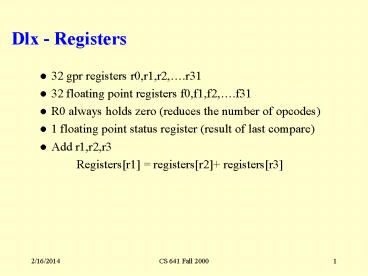Dlx - Registers PowerPoint PPT Presentation
Title: Dlx - Registers
1
Dlx - Registers
- 32 gpr registers r0,r1,r2,.r31
- 32 floating point registers f0,f1,f2,.f31
- R0 always holds zero (reduces the number of
opcodes) - 1 floating point status register (result of last
compare) - Add r1,r2,r3
- Registersr1 registersr2 registersr3
2
Dlx Data Types
- 8 bit bytes, 16 bit half words, 32 bit words
- 32 and 64 bit floating point
- All alu operations work on 32 bits
- Some float operations work on 32 bit floats
- Other float operations work on 64 bit doubles
- Conversion operations between integer and float
3
(No Transcript)
4
(No Transcript)
5
Addressing Modes
- Register (when a value is in a register)
- add r4,r3
- r4 r4 r3
- Immediate or literal (for constants)
- add r4,3
- r4 r4 3
- Displacement or based (accessing local variables)
- add r4,100(r3)
- r4 r4 M100r3
6
Homework Problem 2.2
- Due on Monday
7
So Far Weve Learned
- DLX loading words but addressing bytes
arithmetic on registers only - Instruction meaningadd r1, r2, r3 r1 r2
r3sub r1, r2, r3 r1 r2 r3lw r1,
100(r2) r1 memoryr2100 sw r1,
100(r2) memoryr2100 r1
8
Stored Program Concept
- Instructions are bits
- Programs are stored in memory to be read or
written just like datafetch execute
cycle - Instructions are fetched and put into a special
register - Bits in the register "control" the subsequent
actions - Fetch the next instruction and continue
memory for data, programs, compilers, editors,
etc.
9
Machine Language
- Instructions, like registers and words of data,
are also 32 bits long - Example add r8, r17,r18
- Instruction format 000000
10001 10010 01000 00000100000 op rs rt
rd funct - Can you guess what the field names stand for?
10
Machine Language
- Consider the load-word and store-word
instructions, - What would the regularity principle have us do?
- New principle good design demands a compromise
- Introduce a new type of instruction format
- I-type for data transfer instructions
- Other format was r-type for register
- Example lw r10, 32(r23) op rs rt 16
bit number
11
DlX
Register-Register
5
6
10
11
31
26
0
15
16
20
21
25
Op
Rs1
Rs2
Rd
Opx
Register-Immediate
31
26
0
15
16
20
21
25
immediate
Op
Rs1
Rd
Jump / Call
31
26
0
25
target
Op
12
Assembly Language vs. Machine Language
- Assembly provides convenient symbolic
representation - much easier than writing down numbers
- e.g., destination first
- Machine language is the underlying reality
- e.g., destination is no longer first
- Assembly can provide 'pseudoinstructions'
- e.g., move t0, t1 exists only in Assembly
- would be implemented using add t0,t1,zero
- When considering performance you should count
real instructions

